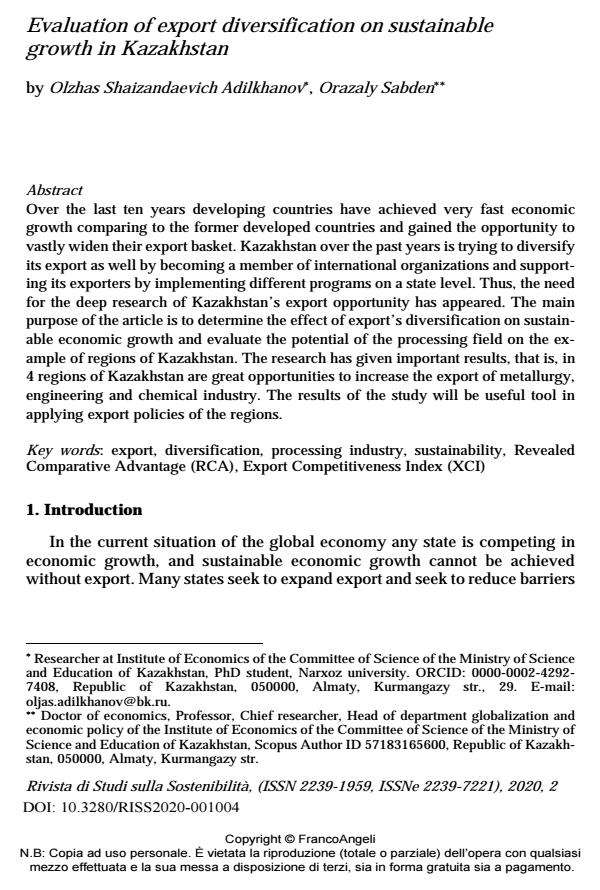Evaluation of export diversification on sustainable growth in Kazakhstan
Journal title RIVISTA DI STUDI SULLA SOSTENIBILITA'
Author/s Olzhas Shaizandaevich Adilkhanov, Orazaly Sabden
Publishing Year 2021 Issue 2020/2 Language English
Pages 15 P. 49-63 File size 166 KB
DOI 10.3280/RISS2020-002004
DOI is like a bar code for intellectual property: to have more infomation
click here
Below, you can see the article first page
If you want to buy this article in PDF format, you can do it, following the instructions to buy download credits

FrancoAngeli is member of Publishers International Linking Association, Inc (PILA), a not-for-profit association which run the CrossRef service enabling links to and from online scholarly content.
Over the last ten years developing countries have achieved very fast economic growth comparing to the former developed countries and gained the opportunity to vastly widen their export basket. Kazakhstan over the past years is trying to diversify its export as well by becoming a member of international organizations and supporting its exporters by implementing different programs on a state level. Thus, the need for the deep research of Kazakhstan’s export opportunity has appeared. The main purpose of the article is to determine the effect of export’s diversification on sustainable economic growth and evaluate the potential of the processing field on the example of regions of Kazakhstan. The research has given important results, that is, in 4 regions of Kazakhstan are great opportunities to increase the export of metallurgy, engineering and chemical industry. The results of the study will be useful tool in applying export policies of the regions.
Keywords: Export, diversification, processing industry, sustainability, Revealed Comparative Advantage (RCA), Export Competitiveness Index (XCI)
- Samen S. (2010). A primer on export diversification: key concepts, theoretical underpinnings and empirical evidence. Washington, DC: World Bank Institute, 1-23.
- Şeker A., Şimdi H. (2019). The Relationship between Economic Complexity Index and Export: The Case of Turkey and Central Asian and Turkic Republics. Ekonomika Regiona [Economy of Region], 15(3): 659-669. DOI: 10.17059/2019-3-3
- Worldbank. (2019). Kazakhstan. -- [Electronic source] https://data.worldbank.org/country/kazakhstan. (Date of access: 29.09.2019).
- Yermakova Z.A., Nikulina Y.N. (2019). Export of educational services from the border region. Economy of the region, 15(1): 191-204. DOI: 10.17059/2019-1-15
- Sachs J., Warner A. (1999). The Big Rush, Natural Resource Booms and Growth. Journal of Development Economics, 59: 43-76. DOI: 10.1016/S0304-3878(99)00005-X
- Regolo J. (2013). Export diversification: how much does the choice of the trading partner matter?. Journal of International Economics, 91(2): 329-342.
- Regolo J. (2017). Manufacturing export diversification and regionalization of trade: Which destinations for newly exported goods?. International Economics, 151: 26-47.
- Mаssоl О., Banal-Estanol А. (2014). Export diversification through resource-based industrialization: The case of natural gas. European Journal of Operational Research, 237(3): 1067-1082.
- Mosley P. (2018). Why has export diversification been so hard to achieve in Africa?.The world economy. 00: 1-20.
- Ministry of National Economy of the Republic of Kazakhstan Committee on Statistics (2019). National Account Statistics. -- [Electronic source] https://stat.gov.kz/official/industry/11/statistic/6. (Date of access: 29.09.2019).
- Ministry of Investment and Development of the Republic of Kazakhstan (2018). Analysis of potential opportunities for export of processed products of Kazakhstan by regions. Astana. – Shanyrak – Media, 334.
- Ministry of Industry and Infrastructure Development of the Republic of Kazakhstan (2019). The state program of industrial and innovative development of the Republic of Kazakhstan for 2020-2025. -- [Electronic source] https://primeminister.kz/kz/gosprogrammy/industrial. (Date of access: 29.09.2019).
- Mehlum H., Moene K., Torvik R. (2006). Cursed by Resources or Institutions. The World Economy, 29(8): 1117-1131.
- Makhlouf Y., Kellard M., Vinogradov D. (2015). Trade openness, export diversification, and political regimes. Economics Letters, 136: 25-27.
- Lederman D., Maloney W. (Eds.) (2006). Natural Resources: Neither Curse Nor Destiny. World Bank and Stanford University Press, 396. DOI: 10.1596/978-0-8213-6545-8
- Lectard P., Rougier E. (2018). Can Developing Countries Gain from Defying Comparative Advantage? Distance to Comparative Advantage, Export Diversification and Sophistication, and the Dynamics of Specialization. World Development, 102: 90-110.
- Koren M., Tenreyro S. (2007). Volatility and Development. Quarterly Journal of Economics, 122(1): 243-287.
- Kodila-Tedika O., Asongu A. (2015). The effect of intelligence on financial development: A cross-country comparison. Intelligence, 51: 1-9.
- Hausmann R., Hwang J., Rodrik D. (2007). What You Export Matters. Journal of Economic Growth, 12: 1-25.
- Hakura D.S. (2009). Output Volatility in Emerging Market and Developing Countries: What Explains the Great Moderation of 1970-2003? Czech Journal of Economics and Finance, 59(3): 229-254.
- Gelb A. (2011). Economic Diversification in Resource Rich Countries. Center for Global Development. World Bank, Washington DC., 55-80.
- Ferranti D., Perry G., Lederman D., Maloney W. (2002). From Natural Resoures to the Knowledge Economy: Trade and Job Quality. Washington, DC: World Bank. DOI: 10.1596/0-8213-5009-9
- Fahim Al-Marhubi (2000). Export Diversification and Growth: an empirical investigation. Applied Economics Letters, 7: 559-562. DOI: 10.1080/13504850050059005
- Cirera X., Marin A., Markwald R. (2015). Explaining export diversification through firm innovation decisions: The case of Brazil. Research Policy, 44: 1962-1973.
- Cesaretti G.P., Covino D., Borrelli I.P., Viola I. (2020). Sustainability, Territories and Circular Economy. Rivista di studi sulla sostenibilità, 1: 11-28. DOI: 10.3280/RISS2020-001002
- Cadot O., Carrere C., Strauss-Kahn V. (2011). Export diversification: what’s behind the hump?. The Review of Economics and Statistics, 93(2): 590-605.
- Akayeva S.A., Sokolov V.N. (2016). On sectoral and technological structural changes necessary for the modernization of the Russian economy. M.I.R. (Modernization. Innovation. Research), 7(3): 38-48.
- Hesse H. (2008). Export Diversification and Economic Growth, 21: 1-23.
Olzhas Shaizandaevich Adilkhanov, Orazaly Sabden, Evaluation of export diversification on sustainable growth in Kazakhstan in "RIVISTA DI STUDI SULLA SOSTENIBILITA'" 2/2020, pp 49-63, DOI: 10.3280/RISS2020-002004